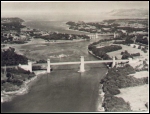|
Loss of the Ship 2. THE PLAN By 1953 Conway was 114 years old. Her sister ships were all long since scrapped and there were very few similar vessels surviving She had last been dry docked in 1938 and was long overdue for another overhaul. In 1949 she was shifted from her Glyn Garth mooring off Bangor to her new mooring off Plas Newydd, which is amply described by Capt Goddard (PDF). For the next four years all energies were focused on establishing the shore establishment and achieving a smooth change of command from Captain Goddard to Captain Hewitt. By 1953 therefore the ship was badly in need of a refit. Work was to have included a better central-heating system and a new copper bottom - last fitted nearly 100 years before! That could only be undertaken in dry dock in Birkenhead. The work was to be organised by the same Mr. Dickie who had completed the 1938 refit. To get to Birkenhead she would first have to return through one of the most dangerous water channels in Britain, The Swellies in the Menai Strait. This is an area of water bounded at one end by the Menai Suspension bridge (just in view at the top of the photo below) and the other by Britannia Bridge, also commonly referred to until the fire in 1974 as the Tubular bridge (at the bottom of the photo). The Menai Strait is a 19 mile long narrow stretch of water between the island of Anglesey and the Gwynedd coast of North Wales with unique tidal conditions. The tide enters the Strait first from the south western Caernarvon end (bottom left) and somewhat later (having passed around the island) a stronger flow of tide enters from the northeastern Beaumaris end (top right).[TwoBdge-1] The two tidal streams are said always to meet between the Swellies and Penmon at the northeastern entrance. While the southwestern entrance acts more like a normal estuary, the presence of these two dissimilar tides in the same waterway results in very unusual tidal conditions throughout the rest of the Strait. In particular, the northeast-going flood stream in the Swellies reverses its direction while the tide is still on the rise, thus the tide continues to rise after the direction of the stream has reversed. Exactly when this occurs is heavily conditioned by atmospheric conditions.[TwoBdge-5a] While the southwest-going stream is nearly always stronger than the northeast-going stream six hours later, there are times during strong southerly winds out at sea when over several consecutive tides there isn't any southwestward flow in the Menai Strait at all. [TwoBdge-5b Conversely, strong northerlies at sea can occasionally result in a southwest-going stream of awesome strength.[TwoBdge-9] Moreover, both northerlies and southerlies will vary both the duration of slack water in the Swellies and the time it occurs. Quite clearly this is not at all the sort of place where you can expect to move a ship simply by following a timetable as Conway attempted to do. Planning was also further severely limited by two quite contradictory considerations:
So owing to the excessive draft of the ship the choice lay between either waiting for positive clearance in the hope that the tugs would prevail against the rapidly accelerating contrary stream which, through being late on the tide she would inevitably meet in the Swellies, or making an earlier transit in order to avoid that contrary stream but with the risk that she might find the bottom. But even if she had found the bottom no real harm would have been done since it was a rising tide.[TwoBdge-11] Thus the highest priority should have been placed upon being through the Swellies before the tide turned against her, and at 22 ft draft she could have passed under Britannia Bridge with the last of the tide behind her that morning any time after 8.40 am[TwoBdge-11] Owing to the unprecedented draft of the ship, Captain Hewitt's calculations were based on the highest tide of the year, and were determined so that he could pass safely over Cheese Rock. But unknown to him, and quite understandably, his calculations appear to have been based on false parameters.[TwoBdge-10/11/12)]It thus seems because of this; "exact timings were eventually fixed and stress was laid on the critical point of the timetable, which was to pass under Britannia Bridge at 9.20 am".[4] As we shall see, everything was to hinge around his rigid adherence to that specific time. This dependence on the highest tide of the year did not fit well with the need to minimise the effect on training. It was decided to shift her first from Plas Newydd back to her old mooring off Glyn Garth to the West of Bangor Pier. She would spend the summer term there[3] before being towed to the West Float dry-dock at Birkenhead at the end of July for refit during the long summer holidays[8]. To further minimise disruption the Easter holiday was to be reduced to "no more than a token... but to give a week's additional summer leave instead. At the same time this will give the ship repairers an extra week".[3] Similar arrangements would apply in reverse for her return in September of that year. |
||
| Page Last Modified (D/M/Y): 5/1/05 |

